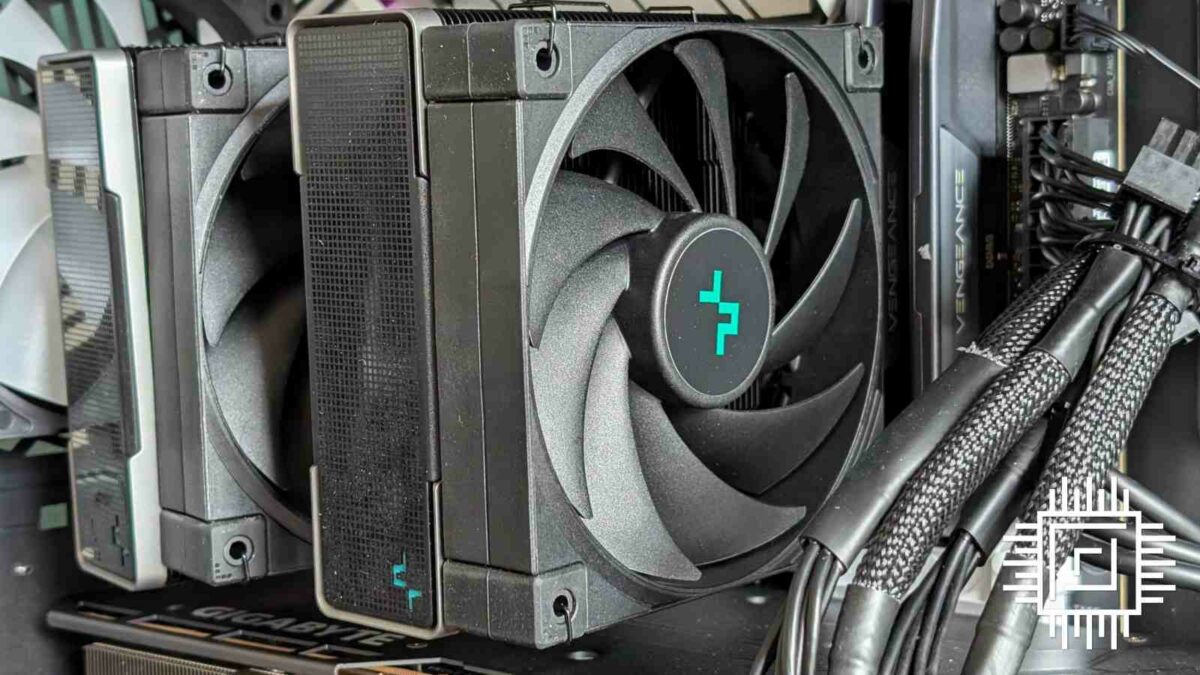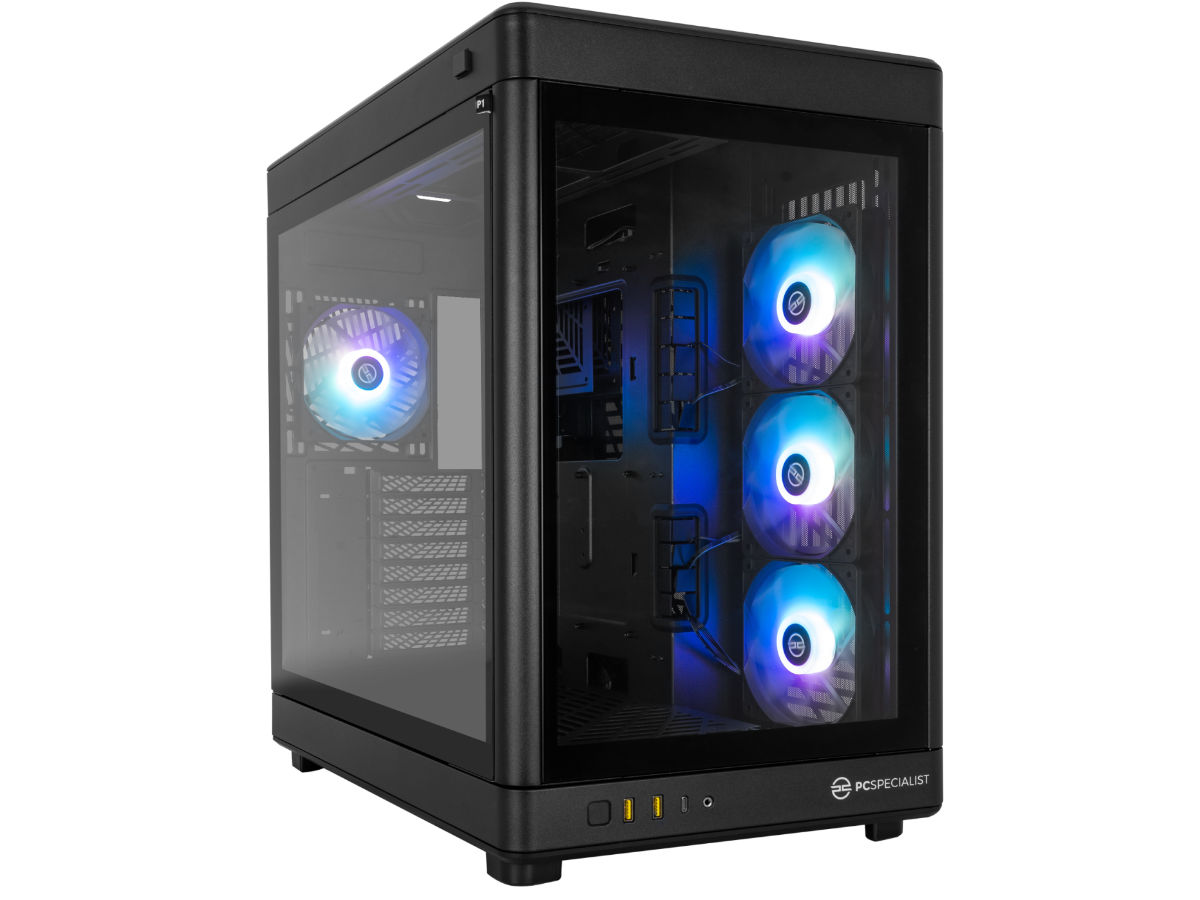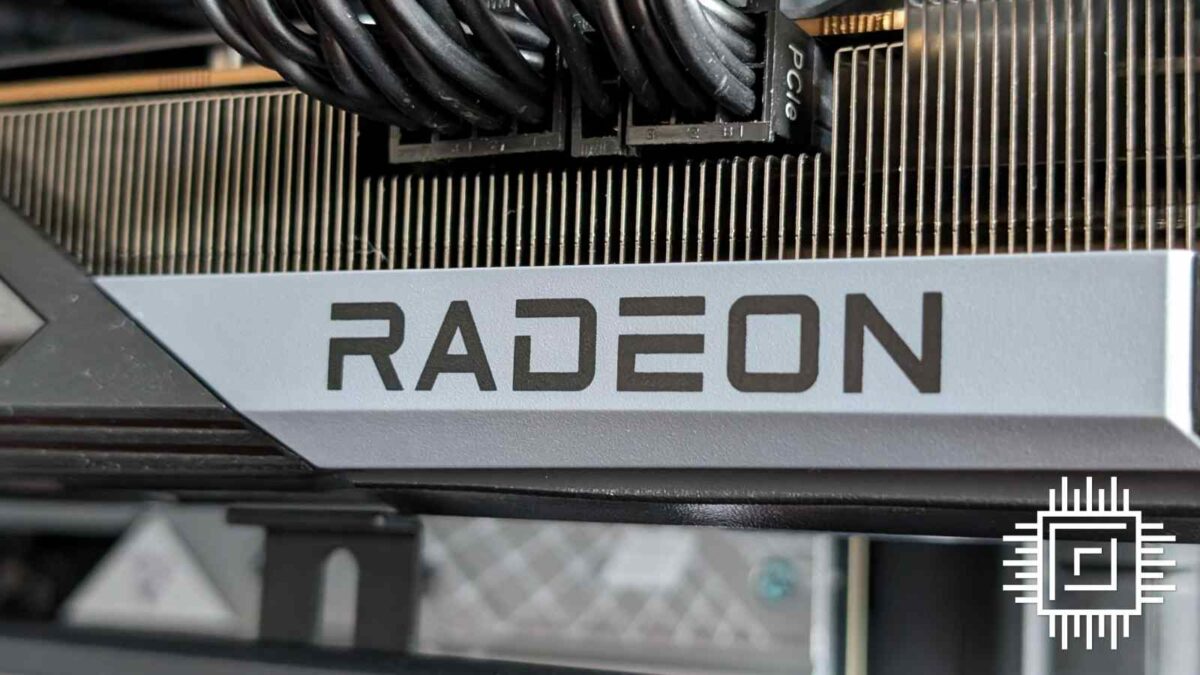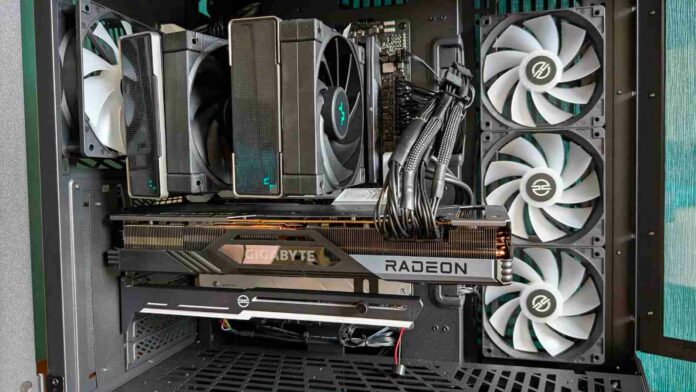If you’re shopping for a new gaming laptop or prebuilt desktop, chances are you’ve come across the phrase ‘AMD Advantage’. While it sounds good, its meaning can be difficult to quickly understand. So, if such a system boasting this big red badge is tempting you but you’re in need of a guide to help you understand the term, we’re all too happy to help.
I’ve spent the past few weeks testing and gaming on a PCSpecialist AMD Advantage System, equipped with some seriously high-end components. In that time, this rig has proven itself to be among one the best gaming PCs I’ve had the pleasure of using. Part of the reason for that is directly to do with the AMD Advantage certification. Without spoiling too much, if my experience is indicative of anything, prospective prebuild purchasers will want to keep an eye out for laptops and desktops with this stamp of approval.

AMD Advantage explained
AMD Advantage is an earned accolade that ensures a system contains the right components and meets Team Red’s performance requirements. To receive this coveted badge, manufacturers must certify their builds using AMD’s testing regime. The company then verifies all results before giving the green light to any endorsement. In a nutshell, it’s a seal of quality.
Every AMD Advantage system comes with discrete Radeon graphics and a Ryzen processor. They also natively support a suite of AMD Smart Technologies, including Smart Access Memory and Video, in addition to software features like Radeon Super Resolution.
Debuting in 2021, AMD Advantage badges were initially only awarded to gaming laptops. From 2023 onwards, though, desktop PCs are now eligible for the award. A further expansion arrived in 2024 via a new ‘Premium’ tier, which demands higher requirements.
| AMD Advantage | AMD Advantage Premium Desktop | |
|---|---|---|
| CPU | Ryzen 5000 series or greater | Up to Ryzen 9 7950X3D |
| GPU | Radeon 6000 series or greater | Up to Radeon RX 7900 XTX |
| Motherboard | N/A | AMD5 X670E |
| RAM | 16GB (dual channel) | 32GB DDR5 AMD EXPO |
| Storage | NVMe SSD | 2TB NVMe SSD |
| Connectivity | N/A | 2.5Gbps LAN Bluetooth 5.2 DisplayPort 2.1 HDMI 2.1A Wi-FI 6E |
| Technologies | Smart Access Memory Smart Access Video |
Same as base tier. |
| Software | AMD Chill HYPR-RX Radeon Anti-Lag Radeon Boost Radeon Image Sharpening Radeon Super Resolution |
Same as base tier. |
| Other | System certification, performance and battery life, component checklist. |
Same as base tier, plus tool-less entry. |
Both desktops and laptops must adhere to the same criteria to qualify for AMD Advantage badging. Meet a higher bar, however, and it’s possible to qualify for the more prestigious AMD Advantage Premium.
There are many differences between the two desktop categories. For example, would-be AMD Advantage Premium PCs require an AM5 X670E motherboard. This is the most feature-rich and expensive chipset available for Socket AM5 boards, setting an appropriately high standard compared to the much looser specifications needed for the base tier.
| AMD Advantage Premium Laptop | |
|---|---|
| CPU | Ryzen 7000 series or greater |
| GPU | Radeon 7000 series |
| RAM | 32GB+ DDR5 |
| Storage | 1TB+ NVMe SSD |
| Display | Adaptive Sync: AMD FreeSync Premium Brightness: Up to 500 nits Refresh rate: Up to 480Hz Resolution: FHD or greater Response time: 3ms or faster |
| Connectivity | Bluetooth 5.2 Wi-Fi 6E |
| Performance | 100+fps gaming 3x longer gameplay on battery 47% more performance with AMD Smart Technologies |
| Thermals | Up to 40°C on WASD keys Up to 52°C on bottom panel Vapour chamber cooling |
| Other | Acoustics regulations Dimensions:17mm or thinner Weight: 3.8lbs or lighter |
For all-in-one systems, the AMD Advantage Premium Laptop tier also includes display requirements. Screens on these devices must support FreeSync Premium and boast response times of 3ms or faster. Most welcomingly, though, are cooling specifics and thermal targets. Placing any system with this badge on your lap shouldn’t feel like you’re slowly cooking your own thighs during use and should keep throttling to a minimum.
Regardless of which badge a system has, though, AMD’s criteria leaves little room for error with both divisions. We imagine requirements will be adjusted following the arrival of Ryzen 9000 series processors, if not shortly after launching RDNA 4 graphics cards.
Either way, it’s a sure sign of AMD’s confidence and progress. Rival schemes such as Ultrabook and Evo have held sway in the prebuilt market for many years, and the appeal of AMD Advantage runs deeper than mere marketing; there’s genuine merit to today’s Radeon and Ryzen combinations.

Test system
Claiming a “truly supreme synergy of performance” through the combined power of Ryzen CPU and Radeon GPU, AMD Advantage promises much. Curious to find out how it holds up, PCSpecialist kindly sent me its Edge Ultra desktop so I can find out.
Despite falling short of achieving AMD Advantage Premium status, presumably due to its M.2 shrouds needing a screwdriver, this is still a seriously powerful system. With it, we have the best graphics card Team Red has to offer, Radeon RX 7900 XTX. Of course, such a pixel pusher demands a similarly high-end processor, and Ryzen 9 7900X3D more than fits the bill.

PCSpecialist Edge Ultra
“With the best that AMD has to offer, PCSpecialist Edge Ultra is dressed head to toe in Team Red, and it’s all the better for it.”
We earn a commission if you make a purchase, at no additional cost to you.
Backing this AMD combo, there’s 32GB of Corsair Vengeance DDR5-6000MHz RAM running in a dual-channel configuration. I also have plenty of fast storage at my disposal, thanks to a 2TB Solidigm P44 Pro SSD, with sequential read speeds of up to 7,000MB/s.
An 80 Plus Gold modular Corsair RM850x power supply runs this impressive configuration of components, plugged into an Asus ROG Strix X670E-A Gaming Wi-Fi motherboard. PCSpecialist also includes four ARGB fans as standard with the build, which make for a satisfying light show through the case’s tempered glass side panels.
Benchmarks
Given that AMD Advantage places so much focus on gaming, I wasted little time in booting up a selection of titles that show off the system’s capabilities.
FSR 3.1
First up we have Ghost of Tsushima. This former PlayStation exclusive was the first game to support AMD FidelityFX Super Resolution (FSR) 3.1, loaded with upscaling and frame generation features. Despite its origins as a PlayStation 4 game, this Director’s Cut edition based on the PlayStation 5 port demands a lot from even powerful PCs.
Running Ghost of Tsushima at a native 4K resolution, using the game’s highest settings, my Edge Ultra system turns in a respectably high 75fps average. However, we’re leaving a large amount of performance on the table. After quickly diving into the settings menu to toggle FSR 3 Frame Generation and run FSR 3 upscaling in Performance mode, I find myself in an altogether smoother gaming experience.
Through Frame Generation alone, average frame rates jump by 60% to 120fps. Combined with Super Resolution upscaling, we reach dizzying heights of 214fps, making for a 185% increase in performance. Even if we place a greater focus on image fidelity, dropping the upscale preset to Quality, we still manage an impressive 173fps average.
Handsome as these frame rates are, they wouldn’t be quite as high if not for AMD Smart Access Memory (SAM). This is Team Red’s implementation of Resizable BAR, requiring a Ryzen processor and Radeon graphics card. In short, it allows a CPU to address the entirety of a GPU’s VRAM, rather than in 256MB chunks, which should boost performance. For context, we have 24GB (24,576MB) of memory in play with our Radeon RX 7900 XTX.
In the case of Ghost of Tsushima, SAM provides a small boost of up to 6fps across the resolution spectrum. When the technology first launched back in 2020, AMD demonstrated it could boost frame rates by as much as 15%, but results will vary game-by-game. Still, free performance is nothing to sniff at, and it’s thankfully enabled by default on all AMD Advantage systems.
Ray tracing
Despite its age, Cyberpunk 2077 remains one of the best showcases for ray tracing out there, bringing even the mightiest of graphics cards to their knees. Radeon RX 7900 XTX learns this the hard way, turning in an average of 21fps using the game’s RT Ultra preset at native 4K. While this result looks poor at first, it’s worth remembering that CD Projekt Red’s RPG makes a similar example out of GeForce RTX 4090 at these settings too.
By enabling FSR in Performance mode, I achieved a much more reasonable frame rate of 59fps. Once again, Smart Access Memory gives us a small boost of 1-3 frames per second, bringing us all the closer to that 60fps threshold. Sadly, the game doesn’t support FSR Frame Generation, but we can inject a similar technology, Fluid Motion Frames (FMF), into the game via AMD’s Software.
Enabling FMF is as simple as flicking a switch, and we now have 108fps to play with. Sure, the appearance and feel of generated frames aren’t as high quality as those produced by a native FSR implementation, but you won’t find similar functionality from competitors. If nothing else, it remains a useful tool to have when performance falls short of a set target. Better still, as it’s driver-based, it works in practically any game.

Smart technologies
Finally, let’s talk about HYPR-RX and other AMD Smart Technologies that further increase the value of AMD Advantage systems. To help demonstrate how they work, I’ll be using the cult classic Prey, which features neither FSR upscaling nor frame generation but can still prove demanding at high resolutions. That and I’ll use any excuse I can to give Prey a shoutout.
Standing in the game’s arboretum while using the highest settings at a native 4K resolution, my Edge Ultra turns in 114fps on average. We’ll find no performance enhancements in the settings menu, but we can juice things up with HYPR-RX via AMD Software. Enabling this gaming experience profile toggles Fluid Motion Frames and a few other Smart Technologies to boost performance.
Aside from FMF, the most effective technology is Radeon Super Resolution. This is another driver-based feature that upscales games to our monitor’s native resolution (in this case, 4K) from a lower base. Working alongside it is Radeon Anti-Lag, reducing input lag by dynamically adjusting frame timing. Finally, we have Radeon Boost, a dynamic resolution scaler.
Combining all of these technologies together, we’re approaching 400fps. Fidelity does admittedly take a small hit, but the performance gains are undeniable. True to its name, jumps like this deliver an advantage made possible by AMD components.
General performance
Let’s take a moment to review the general performance of my AMD Advantage system. As you’d expect, given the quality of the components selected for Edge Ultra and its gaming prowess, it handles other tasks admirably, too.
In Cinebench 2024, my Ryzen 9 7900X3D scores highly, with 116 and 1,538 points in single-core and multi-core benchmarks, respectively. These only increase when climbing up the stack to Ryzen 9 7950X3D, but that’s the best CPU money can buy for a much heftier cost.
CrystalDiskMark shows our Solidigm P44 Pro actually punches above its weight, with 7,400MB/s sequential reads and 6,600MB/s sequential writes. These speeds are typical of high-end PCIe 4.0 drives, and while they’re not as fast as the best SSDs, there are little to no gains to be made in gaming by swapping to PCIe 5.0.

Is AMD Advantage worth it?
Purchasing a prebuilt PC or gaming laptop can be confusing, making efforts like AMD Advantage worthwhile to assist would-be purchasers of new systems. My experience with Edge Ultra has shown me some of the very best that the big red badge has to offer, and I have little reservations about recommending it. AMD perhaps needs to be slightly clearer on just how tool-less a rig needs to be to qualify for Premium because PCSpecialist’s system certainly seems deserving, but it guarantees you quality nonetheless.
With the Ryzen 9000 series around the corner, though, there is one improvement to AMD Advantage that I’d like to see implemented. For instance, clearer performance categories would go a long way in helping purchasers decide between PCs. There’s no reason my £2,500 Edge Ultra, capable of 4K gaming on AM5, should fall under the same category as an AM4 system with a 1080p-oriented Radeon 6500 XT.
Even as someone who builds their own PCs, it’s a helpful guide when it comes to laptops or recommending devices to friends and family. AMD Advantage doesn’t eliminate the need to keep your wits about you when buying a desktop or laptop, but it does make for a helpful guiding star in a sea of systems.
